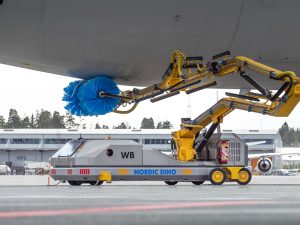 The latest 36th IATA Ground Handling Conference (IGHC) focused on the integration of more sustainable practices into all aspects of ground handling operations. One way to drive more effective sustainability improvements in the ground handling sector is the enhanced Ground Service Equipment (GSE) and transition to electric GSE. But what other advantages do these innovations bring?
The latest 36th IATA Ground Handling Conference (IGHC) focused on the integration of more sustainable practices into all aspects of ground handling operations. One way to drive more effective sustainability improvements in the ground handling sector is the enhanced Ground Service Equipment (GSE) and transition to electric GSE. But what other advantages do these innovations bring?
The aviation industry, seeking a more sustainable future and more efficient procedures, is constantly investing in advanced technologies, adapting them to various fields, such as aircraft maintenance, training, flight operations, safety systems, air traffic management, and GSE.
The green aviation strategy represents modern technologies, reducing the environmental impact of air travel, aiming to lower carbon emissions and improve fuel efficiency. This includes electrification of GSE, helping to cut down emissions and improve the workplace by reducing noise and pollutants. For instance, electric GSE, compared to traditional fuel-powered GSE, can lower noise levels with a reduction ranging from 5.5 to 8.3 dB(A).
One of the enhanced technologies examples, combining the achievement of sustainability goals and improving the efficiency of processes, is aircraft washing robots like Nordic Dino. It is a computerised and self-contained system, built for washing and cleaning aircraft exteriors.
“This innovative robot can help to reduce aircraft exterior cleaning times by up to 80%, it also reduces the number of required staff and minimises the use of water and detergent on every wash,” notes Veronika Andrianovaite, the Chief Commercial Officer of Nordic Dino Robotics AB.
This type of robot can be equipped with electric motors, which reduces environmental impact even more. IATA has projected that transitioning the pre-COVID GSE fleet to electric-powered equipment could reduce GSE-related CO2 emissions by a significant 1.8 million tonnes per year.
Pristine aircraft exterior embodies efficiency, safety, and excellence, benefiting from improved fuel efficiency, which is vital for sustainability, longer-lasting paint, and reduced corrosion risks. In recent years, there has been a noticeable shift from the manufacturers’ side regarding the maintenance of aircraft exteriors, including stricter requirements for carriers, and more detailed inspections.
“Specialised robots, like Nordic Dino, are designed to efficiently clean the aircraft’s exterior, eliminating the need for manual labour-intensive washing procedures. Using manual washing methods, to clean a wide-body aircraft takes between 8 and 10 hours. With the computerised robot, this process is shortened to just 3 to 4 hours, which allows more efficient use of ground time,” explains Veronika Andrianovaite.
Speaking of reduced delays and improved aircraft utilisation, the innovations of GSE are especially important. This includes not only robotic aircraft washers but also automated tugs, and high-speed refuelling systems, helping to minimise aircraft turnaround time and streamline operations.
Automated and semi-autonomous GSE can also reduce human error and increase safety. It can lower the risk of accidents, aircraft damage, and injuries, leading to safer operations.
According to the International Air Transport Association (IATA), enhanced GSE, such as electric or hybrid-powered tugs, high-tech cargo loaders or automated baggage handling systems, holds the potential to reduce ground damage costs by 42% while concurrently creating a safer working environment.
Moreover, enhanced GSE can be equipped with Internet of Things (IoT) technology and artificial intelligence (AI), which provide real-time data on equipment usage, predictive maintenance, and operational performance. The delivered information improves decision-making and reduces downtime.
The innovative GSE is a major step towards greener aviation and more efficient solutions, helping the industry achieve sustainability and high-impact performance goals more quickly.





